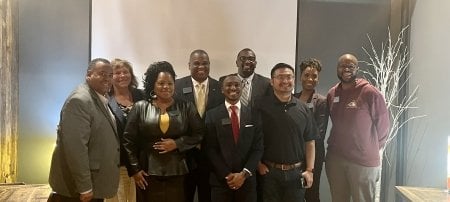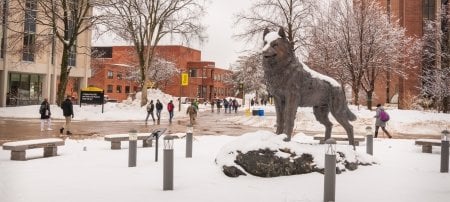David Flaspohler is a professor in Michigan Technological University's College of Forest Resources and Environmental Science. In his guest blog, he reflects on the benefits of seeking out the new and different, and the effort it takes to do so.
"Most of all I hope my work is about a thing that seems to me of the deepest possible importance in our present-day historical moment: finding ways to recognize and love difference. The attempt to see through eyes that are not your own. To understand that your way of looking at the world is not the only one. To think what it might mean to love those things that are not like you. To rejoice in the complexity of things."
Most birds, like most people, tend to stick with their own. Crows tend to avoid associating with ravens. Flocking, in general, happens at the species level. Yet there are many exceptions with chickadees, nuthatches and woodpeckers regularly teaming up to forage together during winter. Everyone in the flock benefits from having more eyes to scan for danger, and competition is reduced because different bird species are often looking for different foods.
About the Researcher
Like birds, academic department members tend to coalesce at tables with members of their own unit when attending cross-campus events. I have even felt a little self-conscious at such events when I make the effort to sit at a table away from members of my own unit. Effort — that word says it all. There is effort and there is ease and when faced with the challenge of conversing over dinner for two hours, most of us look for comfort in the familiar. There is nothing wrong with this attraction to what is known and comfortable; I would guess most of our social primate relatives practice similar behaviors, in part because it is adaptive: Individuals that stick with other known individuals are less likely to encounter unpleasant surprises. Reaching out to the new and different requires vulnerability. Vulnerability always implies risk.
The Paradox
Together with this attraction to others with whom we share some history or trait is the equally powerful human attraction to the new, the different and the unfamiliar. Witness all of human creative output since our ancestors painted rhinoceroses on the walls of French caves 30,000 years ago. We continue to create novel art, music and technology. No other species approaches Homo sapiens as imaginers and creators of the new. And isn’t there something about creation that suggests we humans have a basic attraction to novelty?
Such is the paradox of diversity and difference in the human species: We worship and reward the new and the original even as we are often governed by a desire to surround ourselves with the familiar. As a species, we clearly love diversity and seek it out in forms like art, music and technology. It seems to me that uniting these two powerful human tendencies might offer hope for the future.
MTU's Action Plan
Belonging means you’re an integral part of a community where you can explore and grow with others who will support you. Wayne Gersie, the Vice President for Diversity and Inclusion, says his office exists to foster these values at Michigan Tech — for everyone. Listen to him share his vision for the University’s 120-day action plan for diversity, equity and inclusion.
Reflection and Recognition
For four years, I have been working as part of a small team that assists with the faculty Diversity Literacy training at Michigan Tech. In that position, I have seen that most faculty are working to reflect on and recognize conscious and unconscious bias and to better understand behaviors and practices that promote equity and fairness in the University. In February 2020, USA Today published a list of the 25 least racially diverse colleges and universities in the country including those in which the majority of students identify as white or Black. I was not surprised to find MTU on that list. In 21 years of teaching, I have had only two Black students. About 60% of Americans identify as white nationally, while 90% of MTU undergraduates consider themselves white; the percentage of undergraduates identifying as Black at Michigan Tech is about 1%. This is not to say that MTU lacks other forms of diversity from socioeconomic background, LGBTQ orientation and identification, and neural and cognitive abilities. The best part of my job is meeting and teaching these wonderfully different and interesting young people each semester.
Yet when a university population so dramatically fails to reflect the wider population in important ways, we should be concerned. While my discipline, wildlife ecology, has made great strides in gender equity in recent decades, it still remains one of the whitest professions. Last summer, on the same day that George Floyd was killed by the Minneapolis police, the now infamous video of the woman threatening Christian Cooper, a Black birder in New York’s Central Park, went viral. Birding is already seen as a white, middle class hobby and here was an object lesson in why Black people mostly choose to avoid it. Freedom to birdwatch sounds a little trite until you consider the list of activities available to white males that carry peril for African Americans and even for solitary women: road biking, running, hiking in nature, taking a walk at night, etc.
All of this left me wanting to do something to show my support for justice. I marched in local protests and shared videos on Facebook but otherwise felt largely powerless. Many times, I have asked myself if I am doing enough to support, promote and reach out in ways that contribute to building a university and a community where everyone feels welcome and valued. Diversity is an easy word to embrace; the challenge comes when you must embed it into the practice of your daily life.
Diversity in Universities
As places where many young people first encounter a greater breadth of human diversity, universities can play an important role in acculturating future citizens and workers and building social cohesion at every level, something that is desperately needed today. Through our genes and socialization, humans are exquisitely attuned to appreciate diversity in the color of our skin and hair, our gender, ethnic background, sexual orientation, age, dress and speech patterns. This is the diversity that continues to enrich our culture and our economy.
I have never been much for annual resolutions but here is one I could get behind: In the coming year, when I feel those competing tugs between the easy and comfortable and the hard and vulnerable, I will strive to more often choose the latter. What more worthy and meaningful commitment could we make than to pledge to do that at every opportunity? Imagine the community that could result from that.
Michigan Technological University is an R1 public research university founded in 1885 in Houghton, and is home to nearly 7,500 students from more than 60 countries around the world. Consistently ranked among the best universities in the country for return on investment, Michigan's flagship technological university offers more than 185 undergraduate and graduate degree programs in science and technology, engineering, computing, forestry, business, health professions, humanities, mathematics, social sciences, and the arts. The rural campus is situated just miles from Lake Superior in Michigan's Upper Peninsula, offering year-round opportunities for outdoor adventure.








Comments